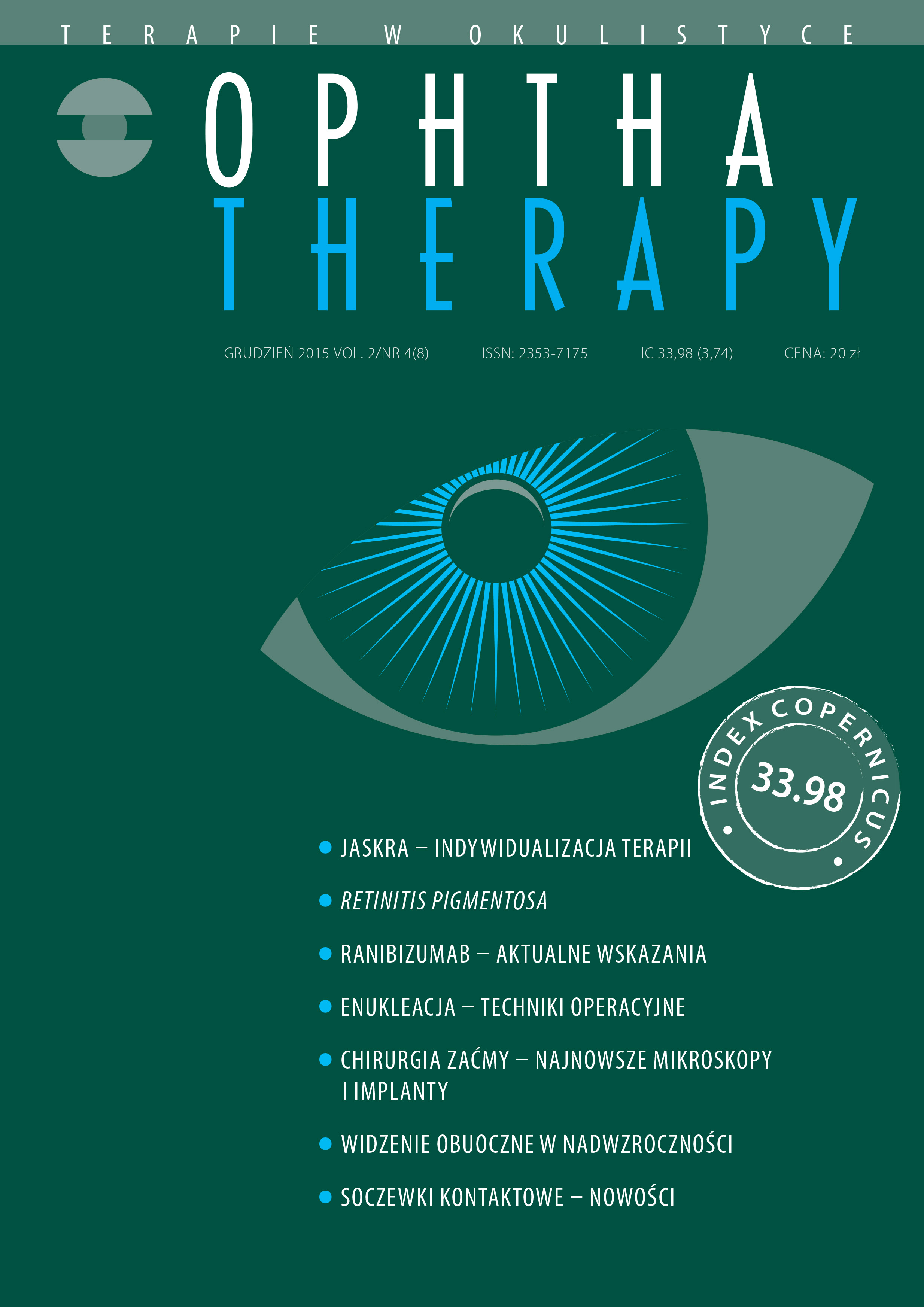Widzenie obuoczne a soczewki kontaktowe w nadwzroczności
##plugins.themes.bootstrap3.article.main##
Abstrakt
Nadwzroczność jest często występującą wadą wzroku, zarówno u dzieci, jak i u dorosłych. Konsekwencje nieskorygowanej nadwzroczności zależą od rodzaju i stopnia nasilenia wady, od wieku, stanu systemu akomodacyjno-wergencyjnego, a także od wymagań, z którymi musi się zmagać układ wzrokowy. Osoby z nadwzrocznością mogą się skarżyć na szereg dolegliwości związanych z niewyraźnym widzeniem, astenopią, dysfunkcjami akomodacji, zaburzeniami widzenia obuocznego, niedowidzeniem czy problemami zezowymi. Prawidłowa i wczesna diagnoza nadwzroczności może zapobiec rozwojowi zaburzeń takich jak zez czy niedowidzenie, a u starszych dzieci – problemom z nauką i czytaniem. Nieskorygowana nadwzroczność może u osób w każdym wieku przyczynić się do dyskomfortu oraz braku efektywności wzrokowej.
Pobrania
##plugins.themes.bootstrap3.article.details##

Utwór dostępny jest na licencji Creative Commons Uznanie autorstwa – Użycie niekomercyjne – Bez utworów zależnych 4.0 Międzynarodowe.
Copyright: © Medical Education sp. z o.o. License allowing third parties to copy and redistribute the material in any medium or format and to remix, transform, and build upon the material, provided the original work is properly cited and states its license.
Address reprint requests to: Medical Education, Marcin Kuźma (marcin.kuzma@mededu.pl)
Bibliografia
2. Sorsby A. The functional anomalies. Section I. Refraction and accommodation. Modern Ophthalmology. JB Lippincott, Philadelphia 1972: 9-29.
3. Augsburger AR. Hyperopia. In: Amos JF (ed). Diagnosis and management in vision care. Butterworths, Boston 1987: 101-19.
4. Rosner J. Hyperopia. In: Grosvenor T, Flom M (ed). Refractive anomalies. Research and clinical applications. Butterworth-Heinemann, Boston 1991: 121-30.
5. Donders FC. On the anomalies of accommodation and refraction of the eye. New Syndenham Society, London; 1864: 80-6.
6. Goldschmidt E. Refraction in the newborn. Acta Ophthalmol. 1969; 47: 570-8.
7. Banks MS. Infant refraction and accommodation. Int Ophthalmol Clin. 1980; 20: 205-32.
8. Atkinson J. Infant vision screening: prediction and prevention of strabismus and amblyopia from refractive screening in the Cambridge Photorefraction Program. In: Simons K (ed). Early visual development normal and abnormal. Oxford University Press, New York 1993: 335-48.
9. Ingram R, Arnold P, Dally S et al. Emmetropisation, squint, and reduced visual acuity after treatment. Br J Ophthalmol. 1991; 75: 414-6.
10. Atkinson J, Anker S, Bobier W et al. Normal emmetropization in infants with spectacle correction for hyperopia. Invest Ophthalmol Vis Sci. 2000; 84: 181-8.
11. Atkinson J, Braddick O, Nardini M et al. Infant hyperopia: detection, distribution, changes and correlates outcomes from the Cambridge infant screening programs. Optom Vis Sci. 2007; 84: 84-96.
12. Wang M, Xiao W. Congenital Cataract: Progress in Surgical Treatment and Postoperative Recovery of Visual Function. Eye Sci. 2015; 30(1): 38-47.
13. Roberts CJ, Adams G. Contact lenses in the management of high anisometropic amblyopia. Eye. 2002; 16: 577-9.
14. Moore BD. Contact lens problems and management in infants, toddlers, and preschool children. Probl Optom. 1990; 2: 365-93.
15. Hirsch MJ, Weymouth FW. Prevalence of refractive anomalies. In: Grosvenor T, Flom M (ed). Refractive anomalies. Research and clinical applications. Butterworth-Heinemann, Boston 1991: 15-38.
16. Gómez-Pedrero JA, Alonso J, Canabal H et al. A generalization of Prentice’s law for lenses with arbitrary refracting surfaces. Ophthalmic Physiol Opt. 1998; 18(6): 514-20.
17. Moore BD. Contact lens therapy for amblyopia. Probl Optom. 1991; 3: 355-68.
18. Saxena RC, Saxena S, Nath R. Hyperopia in branch vein occlusion. Ann Ophthalmol. 1995; 27: 15-8.
19. Ingram RM, Walker C, Wilson JM et al. Prediction of amblyopia and squint by means of refraction at age 1 year. Br J Ophthalmol. 1986; 70: 12-5.
20. Kwong S, Rouse M. Binocular vision and refractive improvements with contact lenses. Peri-Operative Management of Ophthalmic Surgery 2005.
21. Amos JF. Refractive amblyopia: a preventable vision condition. J Am Optom Assoc. 1979; 50: 1153-9.

